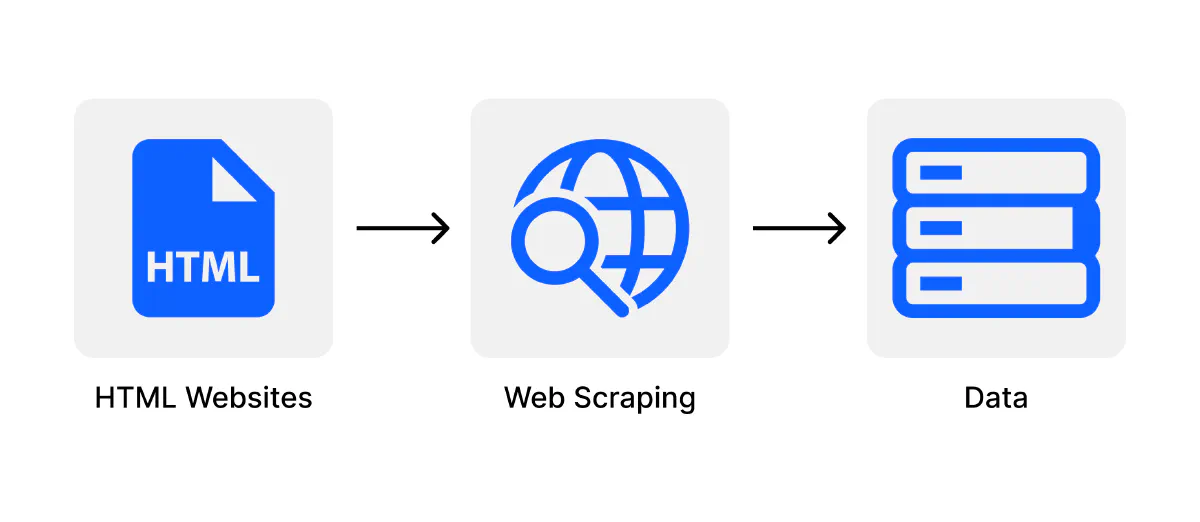Most Popular Web Scraping Techniques & Languages | Scrape.do
Before we start discussing popular web scraping techniques, let’s remember what web scraping is. The word scrape literally refers to scraping data from the web.
The purpose of web scraping is to transform the unstructured data that interests us on a website into structured data that can be stored and analyzed in a local database or a spreadsheet. The best thing about this technique is that you don’t need any prior knowledge or programming knowledge to apply it.
Why Use Web Scraping?
The main advantage of using web scraping on a website is that it allows you to automate data capture that you would otherwise have to manually do. With web scraping, you can compare prices online, find and add contacts to your database, detect changes in web pages, and download information from the web to your computer.
We recommend checking if it’s legal in your country before implementing web scraping to avoid any problems. When you start web scraping, you start to appreciate all the little things crawlers do for us. Because by using web scraping, you can prepare an interesting data transfer solution in a short time. In this article, we will tell you about web scraping techniques.
Sample Tools Used for Web Scraping
There are many ways you can choose to scrape the data from the website using your computer or any software. Most languages used in web development such as Python, Javascript, Ruby, Php have their own pros and cons. For example, in web scraping with JavaScript, you can take advantage of the language’s asynchronous nature. Thus, while the user scrolls the page, you can scrape even the data that seems not yet processed.
Although JavaScript is familiar to both backend and frontend web developers, it can be a bit overwhelming if you are new to programming. You only need to manually add a headless browser call to the scrape handler when scraping with JavaScript.
Therefore, through web scraping, you extract data from the website using a computer program that acts as a web browser. The program requests pages from web servers just like a web browser do, and may even encourage a user to log in to obtain a spreadsheet or database known as web scraping.
There are software tools that can be used to customize web scraping solutions. Check out the examples below:
iMacros
iMacros is a browser extension for sharing, coding, recording, or replaying browser automation, also known as JavaScript. It is specially designed and optimized for form filling and web browsers.
Diffbot
It is a developer of computer vision and machine learning public APIs and algorithms for extracting data to extract data from web scraping. It uses computer learning and vision to automatically extract data from web pages by visually interpreting the pages as a human.
HTTrack
This is an offline web browser that can be used to open the source web browser for free. It allows users to download large websites from the internet and edits the original site’s relative link structure.
Things You Should Know
There are terms and conditions that apply when doing web scraping.
· It is recommended that you read about the legal use of data, as the data you extract from the web should not be used for commercial purposes.
· Since the layout of a website may change from time to time, be sure to revisit the site and rewrite your code as needed.
· Do not be too aggressive when requesting data from the website as this may break the website. When you encounter this situation, you may be under a legal obligation. It is recommended to search one web page per second.
How to Learn Web Scraping Techniques?
There are several resources you can use to learn about web scraping. Your choice is deeply dependent on the programming language you know well. When it comes to web scraping, the main thing is to parse structured or unstructured HTML into structured data. Most programming languages can do this for you.
With this information, you must first know the programming language you will be using, and then undertake the task of seeking resources for that language to accomplish the task. It is important to choose a language you speak to avoid learning curves.
General Techniques Used for Web Scraping
Web scraping is still an evolving process, but it proposes more practical solutions that build on existing techniques and compare applications with their ambitious counterparts. Web scraping techniques are as follows:
1. Copy paste:
Copy paste sites are the only viable solution when they explicitly set the barriers to prevent machine automation.
2. Text pattern matching:
It is one of the best and most reliable web scraping techniques. Text pattern matching includes different programming languages such as PHP, Python, JavaScript, C++, and Ruby, and data is extracted from websites based on UNIX grep commands.
3. HTTP programming:
It is possible to receive dynamic and static websites by sending different HTTP requests and using socket programming.
4. HTML parsing:
It has an extensive collection of pages generated from underlying structured sources such as blogs and websites, databases. HTML parsing uses a program to detect HTML text from different sites. Converts from unedited form to an organized and readable format. HTQL and XQuery are two big data query languages. These are used to better parse HTML pages.
Web pages can include metadata, descriptions, and semantic markup used to find specific pieces of data. If a description is added to a web page, this web scraping technique can be seen as a special case of DOM parsing.
Best Programming Languages for Web Scraping
You can easily perform multiple data scraping and web crawling tasks with PHP, Node.js, C++, and Python. Let’s see:
- Node.js:
This language is great for web crawling and better supports distributed crawling. Node.js is not suitable for large-scale web scraping projects due to limited options and code.
- C & C++:
Both C and C++ offer excellent performance, but the costs of developing web scrapers with these languages are high. Thus, C and C++ are not suitable for small and medium businesses.
- PHP:
PHP is one of the best web scraping languages. It is used to create scanning programs and is easy to learn.
- Python:
It would not be wrong to say that Python uses the most famous web scraping language. It can handle different data extraction and web crawling processes conveniently and smoothly.
Popular Web Scraping Techniques
We have discussed the general web scraping techniques and also popular programming languages which are used in web scraping. Now we will talk about the popular web scraping techniques!
Manual Web Scraping, Copy-Paste
We have mentioned this technique above. It has been the easiest technique for web scraping but not the best sometimes. All you need to do is copy the web content and paste it into your database. However, even though it seems easy; it could turn into something repetitive, meaningless, and something boring. On the other hand, copy and pasting will allow you to overcome the anti-bot defense.
DOM Code Review
Sometimes scrapers use DOM code to extract data deeply. This technique works best for dynamic websites. You will need some plus tools such as XPath to extract data while using DOM.
Vertical Aggregation
Vertical aggregation is generally used to scrape a specific company or customer. It is a great choice to work in the cloud and has high quality data. Also, it can be handled without human interaction.
Google Sheets Scraping
While Google’s API is a very popular tool for web scraping, its use is increasing. You can use the XML AL (,) function to collect the data you need from various websites.


